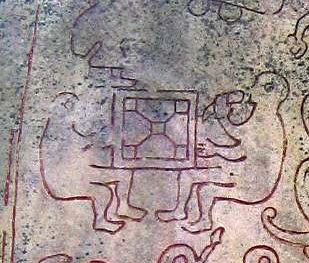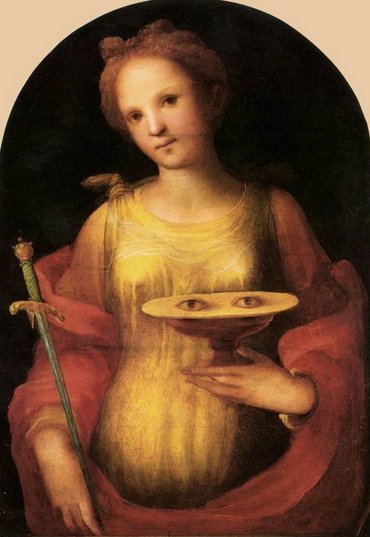Bb10.4
The Turtle (Mother
Earth) had a conjunction with the Rat (Water Serpent) at the
beginning of the year:

 |
 |
 |
 |
|
Bb9-49 |
Bb9-50 |
Bb10-1 (377) |
Bb10-2 (378 →
Saturn) |
... The ordinary year in the
previous Roman calendar consisted of 12 months,
for a total of 355 days. In addition, a 27-day
intercalary month, the Mensis Intercalaris,
was sometimes inserted between February and
March. This intercalary month was formed by
inserting 22 days after the first 23 or 24 days
of February; the last five days of February,
which counted down toward the start of March,
became the last five days of Intercalaris. The
net effect was to add 22 or 23 days to the year,
forming an intercalary year of 377 or 378 days
...
|
|
RIGHT ASCENSION
DAYS AT THE FULL MOON: |
|
No star listed (140) |
θ
Pyxidis (141.5),
MARKAB VELORUM =
κ
Velorum
(141.5),
AL MINHAR AL ASAD (The Nose of the Lion)
=
κ
Leonis
(141.6),
λ
Pyxidis (141.9) |
Star-25 (Horse)
/
ANA-HEU-HEU-PO-5 (Pillar where
debates were held)
ALPHARD (The Horse) =
α
Hydrae
(142.3),
ω
Leonis (142.6),
τ¹
Hydrae (142.7) |
Al Tarf-7 (The End)
ψ
Velorum (143.3),
ALTERF =
λ
Leonis,
τ²
Hydrae (143.4),
ξ
Leonis (143.5)
*102.0 = *143.4 - *41.4 |
 |
|
HELIACAL STARS: |
|
Aug 8 (220) |
9 |
10 |
11 |
|
DAI =
ι
Capricorni
(323.5),
β
Equulei (323.8) |
γ
Pavonis (324.1),
YAN =
ζ
Capricorni
(324.6) |
Al Sa'd al
Su'ud-22 (Luckiest of the Lucky)
/
Emptiness-11 (Rat)
TSIN = 36 Capricorni
(325.2),
ALPHIRK (The Flock) =
β
Cephei
(325.7),
SADALSUD =
β
Aquarii,
ξ
Gruis (325.9) |
No star listed (326) |
|
... In China,
with Capricornus, Pisces, and a part of Sagittarius,
it [Aquarius] constituted the early Serpent, or
Turtle, Tien Yuen; and later was known as
Hiuen Ying, the Dark Warrior and Hero, or Darkly
Flourishing One, the Hiuen Wu, or Hiuen
Heaou, of the Han dynasty, which Dupuis gave as
Hiven Mao. It was a symbol of the emperor
Tchoun Hin, in whose reign was a great deluge;
but after the Jesuits came in it became Paou Ping,
the Precious Vase. It contained three of the
sieu, and headed the list of zodiac signs as the
Rat, which in the far East was the ideograph for
'water', and still so remains in the almanacs of
Central Asia, Cochin China, and Japan ...
 |
|
Febr 7 (342 + 61) |
8 (404) |
9 |
10 |
|
DEC 8 (342 = 64 +
278) |
9 (*260 = *324 -
*64) |
10 (344, *261 → 9
* 29) |
11 |
|
erua ika |
Ma te
kava ra |
e kava haati ia |

... On February 9 the Chorti Ah K'in,
'diviners', begin the agricultural year. Both the 260-day
cycle and the solar year are used in setting dates for
religious and agricultural ceremonies, especially when those
rituals fall at the same time in both calendars. The
ceremony begins when the diviners go to a sacred spring
where they choose five stones with the proper shape and
color. These stones will mark the five positions of the
sacred cosmogram created by the ritual. When the stones are
brought back to the ceremonial house, two diviners start the
ritual by placing the stones on a table in a careful pattern
that reproduces the schematic of the universe. At the same
time, helpers under the table replace last year's diagram
with the new one. They believe that by placing the cosmic
diagram under the base of God at the center of the world
they demonstrate that God dominates the universe. The
priests place the stones in a very particular order. First
the stone that corresponds to the sun in the eastern,
sunrise position of summer solstice is set down; then the
stone corresponding to the western, sunset position of the
same solstice. This is followed by stones representing the
western, sunset position of the winter solstice, then its
eastern, sunrise position. Together these four stones form a
square. They sit at the four corners of the square just as
we saw in the Creation story from the Classic period and in
the Popol Vuh. Finally, the center stone is placed to form
the ancient five-point sign modern researchers called the
quincunx ...

.jpg)
Counting 5 days ahead from February 9 will lead us to
February 14 (→ 2-14
→ 214 → 314 - 100 → 2 * 107):
 |
 |
|
 |
 |
 |
|
Bb10-3 (379) |
Bb10-4 |
Bb10-5 |
Bb10-6 |
Bb10-7 |
|
HELIACAL STARS: |
|
CASTRA = ε Capricorni (327.2),
BUNDA
(Foundation)
= ξ Aquarii
(327.5)
SIRIUS (α Canis Majoris) |
Mahar sha hi-na
Shahū-26 (Western One in the Tail of the Goat)
NASHIRA
(Fortunate One) =
γ
Capricorni
(328.0),
ν
Oct. (328.3),
AZELFAFAGE
(Horse's Foot Track) =
π¹
Cygni,
κ
Capricorni (328.7) |
|
Arkat sha hi-na
Shahū-27 (Eastern One in the Tail of the Goat)
ENIF (The Nose) =
ε
Pegasi,
ERAKIS (the Dancer) =
μ
Cephei
(329.2),
46 CAPRICORNI,
JIH (the Sun) =
κ
Pegasi
(329.3),
ι
Piscis Austrini (329.4),
λ
Capricorni (329.6),
ν
Cephei (329.7),
DENEB ALGIEDI =
δ
Capricorni
(329.8)
*288.0 = *329.4 - *41.4 |
θ
Piscis Austrini (330.1),
λ
Oct.
(330.7) |
KUH (Weeping)
=
μ
Capricorni (331.4),
γ
Gruis (331.5)
*290.0 = *331.4 - *41.4 |
|
Aug 12 |
13 (225) |
14 (409 -
183) |
15 (227) |
16 |
|
Febr 11 (42) |
12 (408 = 365
+ 43) |
13 |
14 (→ 14 *
29½ - 3) |
15 (411 = 350
+ 61) |
|
DEC 12 |
LUCIA (*264) |
14 |
15 |
16 (350 → 347
+ 3) |
|
kua moe ma te tara huki
|
kua ati ra te kava - kua
hakaroa - ko te kava ma te hatu huri |
i vai o amo
hia |
eko te maitaki ma te hokohuki
ku hura hia |
ki te vai o amo
hia |
|
Amo. To carry on one's
shoulders: O Yetú i-amo-ai te tatauró ki ruga
ki-te maúga Kalvario. Jesus carried his
cross up to the Calvary. Amoga, bundle;
to tie in a bundle: he-amoga i te hukahuka,
to tie a bundle of wood. Vanaga. 1. A yoke,
to carry; amoga, burden, load. 2. To
bend, to beat a path. Churchill. Âmo. 1.
To clean, to clean oneself: he-âmo i te umu,
to clean the earth oven; ka-âmo te hare,
ka haka-maitaki, clean the house, make it
good; he-âmo i te ariga, to clean one's
face wetting it with one's hand. 2. Clear;
ku-âmo-á te ragi, the sky is clear. 3. To
slip, to slide, to glide (see pei-âmo).
Ámoámo, to lick up, to lap up, to dry; to
slap one's body dry (after swimming or bathing):
he-âmoâmo i te vaihai rima.
Vanaga. Amoamo. 1. To feed, to graze. 2.
To spread, to stretch (used of keete).
Churchill.
... In China, every year about the beginning of
April, certain officials called Sz'hüen
used of old to go about the country armed with
wooden clappers. Their business was to summon
the people and command them to put out every
fire. This was the beginning of the season
called Han-shih-tsieh, or 'eating of cold
food'. For three days all household fires
remained extinct as a preparation for the solemn
renewal of the fire, which took place on the
fifth or sixth day after the winter solstice
[Sic!]
...

... Once upon
a time there was an old woman who owned a great
potato field where she planted her potatoes in
spring and harvested them in autumn. She was
famous all around for her many varieties of
wonderful potatoes, and she had enough of them
to sell at the market place. She planted her
potatoes 7 in a row, placing her foot in front
of her as a measure from one potato to the next.
Then she marked the place with a bean - which
would also give nourishment to the surrounding
potatoes. Next she changed variety and planted 7
more followed by another bean, and this was the
pattern she followed until all her 214 varieties
had been put down in their proper places. She
had drawn a map which she followed and from
where each sort of potato could be located at
the proper time for its harvest. I was
fascinated, when I happened to stumble on this
Swedish TV program, because my 'once upon a
time' was now and 214 (= 2 * 107) was surely no
coincidence. She knew what she was doing. Let's
therefore count: 214 * 7 (potatoes) + 213
(beans) = 1711. So what? Probably because 1711 =
59 * 29 ...
... Early on Sunday morning, 14 February 1779,
Captain Cook went ashore with a party of marines
to take the Hawaiian king, Kalaniopu'u, hostage
against the return of the Discovery's cutter,
stolen the night before in a bold maneuver - of
which, however, the amiable old ruler was
innocent. At the decisive moment, Cook and
Kalaniopu'u, the God and the King, will confront
each other as cosmic adversaries. Permit me thus
an anthropological reading of the historical
texts. For in all the confused Tolstoian
narratives of the affray - among which the
judicious Beaglehole refuses to choose - the one
recurrent certainty is a dramatic structure with
the properties of a ritual transformation.
During the passage inland to find the king,
thence seaward with his royal hostage, Cook is
metamorphosed from a being of veneration to an
object of hostility. When he came ashore, the
common people as usual dispersed before him and
prostrated face to earth; but in the end he was
himself precipitated face down in the water by a
chief's weapon, an iron trade dagger, to be
rushed upon by a mob exulting over him, and
seeming to add to their own honors by the part
they could claim in his death: 'snatching the
daggers from each other', reads Mr. Burney's
account, 'out of eagerness to have their share
in killing him'. In the final ritual inversion,
Cook's body would be offered in sacrifice by the
Hawaiian King ...
... The Hawaiian woman who was interviewed
chuckled because the assassination of Captain
Cook coincided with the day we have named All
Hearts' Day - when in February 14 (2-14) the
war-god Kuu returned to power ...
 |
The
Mesopotamian 26th and 27th ecliptic constellations
were at the beginning of their list. I.e., with
Nashira visible close to the Full Moon in DECEMBER
13 → Lucia:

|





.jpg)







